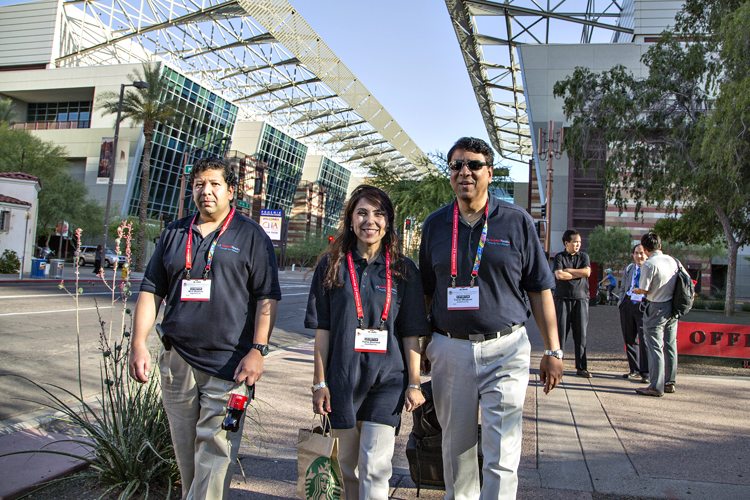Most people don’t think of tourism as an export industry. And when it comes to Arizona, the state’s tourism export industry is an impact player.
Just think of the five C’s of this export industry: Climate, cacti, canyons, culture and conventions. And that’s just the C’s.
How big the the state’s tourism export industry? Last year, 43 million people visited our desert state and during their stays, they collectively spent $21.2 billion. Tourism is more than an economic guiding force; it’s an export industry that is providing funding for our education system and infrastructure and impacting our overall economy in the best ways possible, according to experts from the Hospitality Sales & Marketing International Arizona Chapter.
Bringing in the big bucks and business
From Phoenix and Glendale to Flagstaff and Tucson, the business of conventions and meetings is booming in Arizona. This is no doubt a result of Arizona’s land of plenty in terms of hospitality, meeting space and unique, engaging amenities, but there’s more to the story. Arizona’s tourism entities are vigilant, creative and persistent in marketing the state and creating innovative campaign strategies to draw in new business and opportunities.
“This year, Experience Scottsdale is focused on generating business from new destinations, in addition to our key target markets,” says, Experience Scottsdale President and CEO Rachel Sacco. “We’ve been hitting the road for trade shows, sales calls and client events in cities like Austin, Nashville and Kansas City. In doing so, we hope to introduce planners to the destination and build lasting relationships that bring new business to the community.”
“Hilton has created a co-op for Phoenix area hotels,” adds Robert Rauch, CHA president and CEO of RAR Hospitality. “They are pooling the marketing dollars from Phoenix-area Hilton branded hotels and using that for more extensive advertising specifically to the Phoenix market. Some areas of focus are drive markets, Cvent (company that specializes in meetings management technology) campaigns, weddings and sporting events.”
And, while forces in hospitality, meeting planning and tourism unite, cities are working together to increase Arizona’s offerings even more.
“Greater Phoenix is continually welcoming new bars, restaurants, resurgent neighborhoods and micro-hoods that are adding vibrancy under the Sonoran Desert sky,” says Lorne Edwards, vice president of sales and services for Visit Phoenix. “We will continue to leverage the collective resources of our greater hospitality partners, as well as those within the local industry to create unique convention experiences that provide engaging content and entertainment.”
The impact of the export
Let’s circle back to the previously mentioned statistics, this time adding another number that emphasizes the value of Arizona’s tourism as an “export industry.” In Scottsdale alone, nearly 9 million domestic visitors explored the city, spending $1.5 billion.
“Those are dollars spent at hotels and resorts, restaurants, shops and attractions,” Sacco says.
“The Phoenix area offers many top-tier hotels and resorts, but many people don’t know how much group business fills these hotels every year,” Edwards explains. “According to STR Inc. reports, from January through November 2017, nearly half of all occupancy at the luxury and upscale hotels in the Phoenix area was from group business — those booking at least 10 or more rooms per night.”
Individual visitors, groups and large conventions assuredly continue to reflect impressive spending, but again, there’s more to the story of our export-tourism industry.
“These 18 million -plus visitors generated $443 million in state and local tax revenue in 2016,” Edwards says.
This revenue is what creates jobs – 184,200 in direct employment, according to Rauch.
Revenue revs economy
“Tax revenue from our meetings and conventions are used for everything from police, fire and roads to education,” Rauch says. “Because Gov. Doug Ducey is both education-minded and economic development-minded, those added tax dollars can be put to work to benefit both education and economic development.”
Scottsdale, similar to Phoenix, can thank group meetings and business for the influx of tax revenue, which accounts for nearly half of all tax revenue in the city, according to Sacco.
“In the first half of the 2017-18 fiscal year, Experience Scottsdale booked 285 meetings and 90,624 incremental room nights into Scottsdale market area hotels and resorts,” she says. “Our efforts equate to $44.5 million in economic impact.”
In the case of the City of Phoenix, a 5.3 percent bed tax is applied to guests’ hotel stays, with a small portion going to Visit Phoenix and destination marketing efforts, and the rest going toward community development and improvement and the city’s general fund.
“When groups host meetings in Phoenix,” Edwards says, “they are contributing to the local economy’s continual growth. The city and its residents rely on the taxes generated by the hotels to support city services, and these hotels need a steady flow of group business to stay full.”




